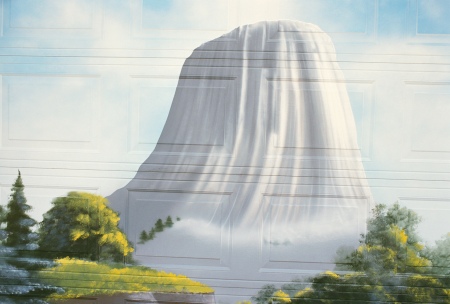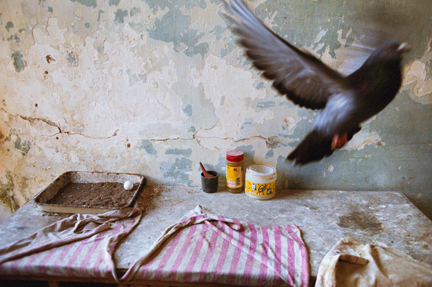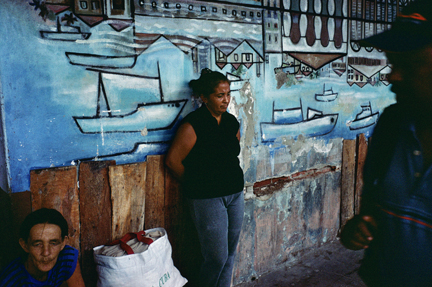For our fifth TWO LOOKS column, Rebecca and I are featuring the work of photojournalists CARMINE GALASSO, a staff photographer for New Jersey’s The Record newspaper, and NINA BERMAN of NOOR, a photo agency based in Amsterdam. This New York-based couple both have work that strikes a more evidently socio-political note than some of the other work we’ve shown on this blog. Carmine’s photograph comes from his book, Crosses, a work that documents a world that many of us have heard of, but have rarely seen: the victims of clergy abuse. His ability to get inside this hidden world is remarkable. Nina’s picture comes from her book, Purple Hearts, one of the first photographic examinations of wounded U.S. veterans from the ongoing war in Iraq. It’s a profoundly disturbing book that examines the effects on our society of this terrible war. A later series of Nina’s on a wounded Marine is exhibited in this year’s Whitney Biennial, a rare occurrence for a photojournalist.
It’s great to see that despite few outlets for committed photojournalism, despite the fact that there are extremely limited sources for photographic production, these two have both managed to complete serious explorations of these often-unexamined subjects.––Alex Webb
CARMINE ON NINA’S “Randall Clunen, 2004”

Nina Berman, Randall Clunen, 2004
When I saw Nina’s take from the first shoot for her book. “Purple Hearts,” I knew, of course, that the subject matter would be well-researched, compelling, provocative, and timely. I knew that from having lived with her projects, her images, for so long, and from having helped to edit them over the years.
What I didn’t expect though, was that Nina was such an accomplished portraitist. Her work until this project, was gritty and colorful views of subjects with Nina’s jarring socio-political take on things. Often her pictures give a not-so-subtle “F.U.” to someone, some group, while being masterfully artful.
“Purple Hearts” is a tough subject, and though these portraits of severely wounded veterans of the Iraq War may be tough to look at for some, Nina displayed the maturity of a seasoned photojournalist, portraying these veterans in a dignified way, not holding back, yet not exploiting them. I’ve always thought she gently forces us to look at the injuries and make a decision on where we stand on the war. Never trying to influence us to take a stand either way though. I think that’s why this book became so popular with people on both sides of the equation. Odd? Maybe.
The portrait on the cover of “Purple Hearts,” shows 19-year-old, Pfc. Randall Clunen, 101st Airborne, from Salem, Ohio. He’s the youngest veteran in the book, and while pulling guard duty in Tal Afar, Iraq, a suicide bomber somehow got through security and blew up himself and his car. Flying schrapnel ripped into his face. Several surgeries later, young Clunen’s face is left scarred. Though, compared to most of the other veterans’ injuries, the self-professed adrenaline junky’s injuries do not immediately appear as debilitating -– he didn’t lose an arm or a leg like so many.
Nina shows him through an icy window looking strong, some might even say proud. And because his wounds are obscured, I was, at first, wondering about his psychological, not physical wounds.
I really like the fact that this young guy is not made to look freakish. Nina put him on the cover and forces us to consider the layers of his and the other subjects’ wounds. I keep looking at him and wondering what he’s thinking.
It’s so simple and not. She dares us to take a stand –- either way. How could you not?
That’s so Nina. –– Carmine Galasso
NINA’S WEBSITE
NINA ON CARMINE’S “Rita Milla and daughter, 2005”

Carmine Galasso, Rita Milla and Daughter, 2005
Of all the remarkable portraits in Carmine’s book “Crosses,” this one leaves me utterly crushed.
It’s deceptively simple yet full of tension and discomfort. The decorative objects in the room –- the lamp, the figurine, the table cover — speak to a refined domesticity, yet the body language of the subjects, the contrast in their clothing, and the skewed pictures signal something profoundly disturbed.
When I look at it, it’s hard for me to imagine how Carmine got into that space, much less take the picture.
The woman on the right is the mother who is Rita Milla. Throughout her teen years and until she was twenty, she was forced to have sex with Catholic priests. The sexual violations ended when the seventh priest impregnated her at age 20.
The woman on the left is her daughter Jackie, whose father was that seventh priest. In the photo, coincidentally, Jackie is also pregnant.
Of her daughter, Rita says, “She was the only innocent in all of this. I was not a good mother to her. My mom raised her mostly. I was just so depressed. I did not want to deal with anybody or anything. It’s sad because she really tried to be lovable.”
Before taking the photograph, she confessed to Carmine the whole excruciating tale of betrayal and assault, not just by the priests, but the bishop who then covered it up.
Carmine is a big man, immediately likeable, with strong hands and an open heart. No doubt, the ease of his personality, his gentle ways, and his clear indignation over the abuses of the Catholic Church, engendered in Rita and the 28 other survivors in his book, a degree of trust that cannot be overestimated.
Of this picture Carmine says, “I could see immediately the tension between the two and that it was obvious to me that the mother was the child needing support and the daughter was the reluctant mother.”
As a photographer, I am humbled as to how easily he can communicate complicated, deeply felt emotions, without using any of the typical photo tricks so often seen in portraiture –- harsh lighting or ultra close-ups.
For him, the photographic portrait is truly a natural calling and leaves me endlessly inspired. — Nina Berman
FOR MORE OF CARMINE’S PHOTOGRAPHS















